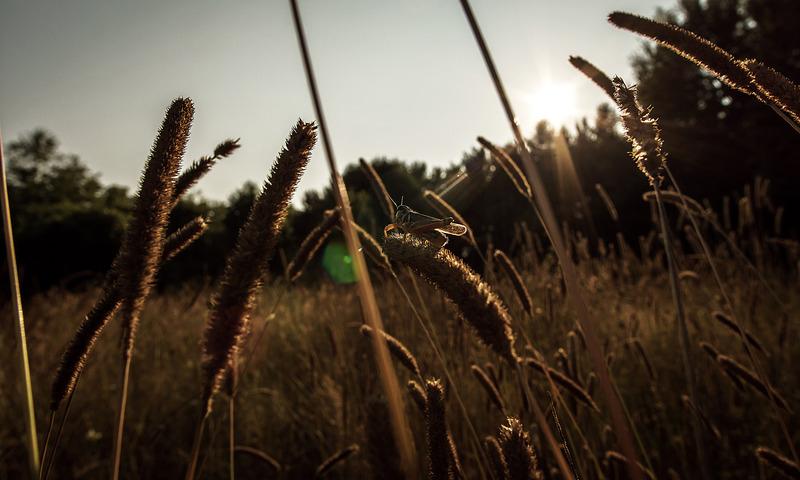
Pasture and Forage Minute: Grasshopper Control, Sub-irrigated Meadow Hay Harvest
Grazing with the Weather
By Ben BeckmanPrecipitation and temperature play major roles in pasture productivity, and knowing how to adjust grazing to match current conditions is key. Are you shifting your management to meet pasture conditions?
Stocking and grazing management are not static things. When production is limited, especially during a drought period, stretching forage resources is a high priority. By this point in the year, our pastures have produced the vast majority of forage that we will get. Using temporary electric fence to cross fence can increase utilization, slowing down a grazing rotation and stretching forage considerably.
This is especially true when plants become dormant due to lack of precipitation or heat. Typically, utilization seeks to balance animal demand and plant health, but taking more of a dormant plant without damaging the crown has little impact on overall plant health.
On the flip side, grass that is getting tall and lanky ahead of a grazing rotation could benefit from flash grazing. Moving animals on and off quick can help keep plants from getting overmature. Keep up this fast pace while growth is rapid. Once growth slows, then the rotation can slow down as well.
Speeding up grazing when things are wet and slowing down during dry times is a good rule of thumb to use as we adjust to the weather Mother Nature throws our way. Doing so can help you find the perfect balance for your pasture and animal health.
Grasshopper Management
By Samantha DanielLast year’s drought conditions and results from adult grasshopper surveys indicated the potential for grasshopper outbreaks this year; however, precipitation and temperature can impact the severity of outbreaks. Keeping an eye on fields this summer can help mitigate economic loss from grasshopper feeding.
Because grasshoppers tend to thrive in dry, hot conditions while outbreaks can be severely limited by cool, wet spring weather, producers in eastern Nebraska might see an increase in outbreaks this summer, while western Nebraska grasshopper populations may be reduced. It is still recommended that producers throughout the state scout their fields and select proper treatment protocols when needed.
One of the best ways to scout for grasshoppers is to use the square foot method. Randomly select an area several feet away and visualize a one square-foot area around that spot. Walk toward this spot and count the number of grasshoppers you see in or jumping out of this area. Repeat this procedure 18 times and divide the total number of grasshoppers by two. This will give you the number of grasshoppers per square yard. Economic thresholds for grasshoppers range from eight to 40 grasshoppers per square yard, depending on a variety of factors. Keep in mind that control is easiest before grasshoppers reach the adult stage.
Grasshoppers may be controlled by applying insecticides as sprays or baits. The insecticides currently registered for use on rangeland are dimilin, malathion and carbaryl. Rates for these products are listed on the labels. If larger grasshoppers are targeted, the higher-labeled rates should be used. Other insecticides are labeled for control of grasshoppers in forages, grasses, alfalfa and other crops.
Sub-irrigated Meadow Hay Harvest
By Jerry VoleskyJuly traditionally means the beginning of the haying season for Sandhills sub-irrigated meadows. A key point related to the quality of meadow hay is harvest date. Crude protein and energy concentration decline as plants become stemmy and mature. As this happens, the types of livestock that can be fed that hay with little or no supplements become more limited.
A good practice can be to record harvest dates for different meadow fields. Quality of hay cut in early July could vary significantly compared to hay cut in late-July or August. Including notes if hay was impacted by rain before baling can also be useful. This information, along with hay tests, can be useful when making hay feeding decisions this winter and next spring. Also remember that earlier meadow harvest will provide a longer regrowth period and extra growth for fall grazing.
Within some meadows, there can be variation in hay quality depending on plant species that are present. Sedges and rushes are most common in the wettest and lower parts of meadows and these species are lower in quality compared to grasses.
The extra rain received in central and western Nebraska this year has been mostly welcome. But excess rain can make some meadows impossible to even get in to cut the hay.
With the high demand for hay this year, most ranchers will wait until the ground dries and firms up enough to drive haying equipment over it. But the quality of this late cut hay will be lower.
Online Master of Science in Agronomy
With a focus on industry applications and research, the online program is designed with maximum flexibility for today's working professionals.
